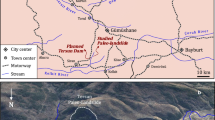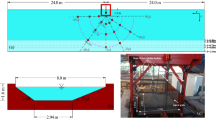Abstract
This paper presents a study of the effects of a potential landslide in La Yesca Reservoir, Jalisco-Nayarit, Mexico. The main purpose of the paper is to predict the maximum wave amplitude, wave run-up, and dam overtopping. The landslide is formed by an unstable slope of more than 24 Mm3 that is partially submerged for the range of the reservoir operation levels. The dynamics of the sliding mass were obtained in detail considering that it moves over a pair of failure surfaces with the potential rupture of a third surface. The paper presents results of a physical model of the reservoir based on Froude similitude (scale 1:200). Impulse waves are produced with a solid wedge shape slide as it moves on rails. The movement was calibrated to reproduce the dynamics of the landslide. Also, numerical modelling of the event was performed with a 2D implicit model that solves the two-dimensional shallow water equations. In this case, the impulse waves were generated at each time increment with the variation of the ground elevation (obtained from the dynamics of the landslide) for the mesh points where the landslide passes. The results of both studies are similar.















Similar content being viewed by others
References
Ataie-Ashtiani B, Najafi-Jilani A (2008) Laboratory investigations on impulsive waves caused by underwater landslide. Coast Eng 55(12):989–1004. doi:10.1016/j.coastaleng.2008.03.003
Ataie-Ashtiani B, Nik-Khah A (2008a) Impulsive waves caused by subaerial landslides. Environ Fluid Mech 8:263–280. doi:10.1007/s10652-008-9074-7
Ataie-Ashtiani B, Nik-Khah A (2008b) Laboratory investigations on impulsive waves caused by underwater landslide. Coast Eng 55:989–1004. doi:10.1016/j.coastaleng.2008.03.003
Ataie-Ashtiani B, Yavari-Ramshe S (2011) Numerical simulation of wave generated by landslide incidents in dam reservoirs. Landslides 8(4):417–432. doi:10.1007/s10346-011-0258-8
Bateman A, Bregoli F, Medina V, Rast M, Bentz C (2011) Setup of an experimental device for high-speed debris flows generating 2D impulsive waves. River, costal and estuarine morphodynamics 2011. Tsinghua University Press, Beijing
Cruden D, Varnes D (1996) Landslide types and processes. In: Turner A K, Shuster R L (eds) Landslides: investigation and itigation. Transp Res Board, Spec Rep 247:36–75
Davidson D, McCartney B (1975) Water waves generated by landslides in reservoirs. J Hydraul Div ASCE 101:1489–1501
DHI (2009) MIKE 21 and MIKE 3 FLOW MODEL FM, Hydrodynamic and transport module. Scientific Documentation
Di Risio M (2005) Landslide generated impulsive waves: generation and interaction with plane slopes. An experimental and analytical study. PhD thesis University of Roma Tre Rome
Di Risio M, Sammarco P (2008) Analytical modeling of landslide-generated waves. J Waterw Port Coast Ocean Eng 134(1):53–60. doi:10.1061/(ASCE)0733-950X(2008)134:1(53)
Di Risio M, Bellotti G, Panizzo A, De Girolamo P (2009) Three-dimensional experiments on landslide generated waves at a sloping coast. Coast Eng 56(1–5):659–671. doi:10.1016/j.coastaleng.2009.01.009
Echávez AG (1982) Waves generated by landslides in a reservoir. International Conference on the Hydraulic Modelling if Civil Engineering Structures, Coventry England
Enet F, Grilli S (2007) Experimental study of tsunami generation by three-dimensional rigid underwater landslides. J Waterw Port Coast Ocean Eng SPECIAL ISSUE: Tsunami Engineering 133:442–454. doi:10.1061/(ASCE)0733-950X(2007)133:6(442)
Fernandes R, Antunes J (2007) Landslides into reservoirs and their impacts on banks. Environ Fluid Mech 7(6):481–493. doi:10.1007/s10652-007-9039-2
Fritz HM (2002) Initial phase of landslide generated impulse waves. PhD thesis, ETH Zurich, Zurich.
Fritz HM, Hager WH, Minor HE (2003a) Landslide generated impulse waves. 1. Instantaneous flow fields. Exp Fluids 35(6):505–519. doi:10.1007/s00348-003-0659-0
Fritz HM, Hager WH, Minor HE (2003b) Landslide generated impulse waves. 2. Hydrodynamic impact craters. Exp Fluids 35(6):520–532. doi:10.1007/s00348-003-0660-7
Fritz HM, Hager WH, Minor HE (2004) Near field characteristics of landslide generated impulse waves. Journal of Waterway, Port, Coastal and Ocean Engineering 130(6): 287–302
Fuhrman D, Madsen P (2009) Tsunami generation, propagation, and run-up with a high-order Boussinesq model. Coast Eng 56(7):747–758. doi:10.1016/j.coastaleng.2009.02.004
Gabl R, Kapeller G, Aufleger M (2009) The effect of avalanche impulse waves in reservoirs, 33rd IAHR Congress: water engineering for a sustainable EnviroNumerical Modelent, IAHR, Vancouver, British Columbia, Canada 2500–2505
GEIC, CFE (2012) Landslide report Mesa de Palos Verdes, geology and geotechnics
Grilli S, Watts P (2005) Tsunami generation by submarine mass failure part I: modeling, experimental validation, and sensitivity analysis. J Waterw Port Coast Ocean Eng 131(6):283–297. doi:10.1061/(ASCE)0733-950X(2005)131:6(283)
Hampton M, Lee H, Locat J (1996) Submarine landslides. Rev Geophys 34(1):33–59. doi:10.1029/95RG03287
Harbitz CB (1992) Model simulations of tsunamis generated by the Storegga slides. Mar Geol 105:1–21
Heller V (2007) Landslide generated impulse waves—Prediction of near field characteristics. Ph.D. Thesis 17531, ETH Zurich, Zürich
Heller V, Hager W, Minor H (2008) Scale effects in subaerial landslide generated impulse waves. Exp Fluids 44(5):691–703. doi:10.1007/s00348-007-0427-7
Huang B, Yin Y, Wang S, Chen X, Liu G, Jiang Z, Liu J (2013) A physical similarity model of an impulsive wave generated by Gongjiafang landslide in Three Gorges reservoir, China. Lanslides. doi:10.1007/s10346-013-0453-x
Huang B, Yin Y, Chen X, Liu G, Wang S, Jiang Z (2014) Experimental modeling of tsunamis generated by subaerial landslides: two case studies of the Three Gorges reservoir, China. Environ Earth Sci 71:3813–3825. doi:10.1007/s12665-013-2765-5
Huber A, Hager W (1997) Forecasting impulse waves in reservoirs. Commision Internationale des Grands Barrages, 19 Congres des Grand Barrages, Florence 993–1005
Hunt B (1988) Water waves generated by distant landslides. J Hydraul Res 26(3):307–322. doi:10.1080/00221688809499214
Kamphuis, J, Bowering R (1970) Impulse waves generated by landslides. In: Proceedings of the International Conference on Coastal Engineering 575–588
Kofoed-Hansen H, Cifres Gimenez E, Kronborg P (2001) Modelling of landslide-generated waves in MIKE21. 4th DHI Software Conference, Elsinore, DeNumerical Modelark 6–8
Körner J (1976) Reichweite und Geschwindigkeit von Bergstürzen und Fließschneelawinen. Rock Mech 8(4):225–256. doi:10.1007/BF01259363
Mathews JH, Fink KD (1999) Numerical methods using MATLAB, Prentice Hall Inc
Mohammed F, Fritz HM (2012) Physical modeling of tsunamis generated by three-dimensional deformable granular landslides. J Geophys Res 117:C11015
Panizzo A, De Girolamo P, Petaccia A (2005) Forecasting impulse waves generated by subaerial landslides. J Geophys Res Oceans 110(12):1–23. doi:10.1029/2004JC002778
Pastor M, Herreros I, Fernández J, Mira P, Haddad B, Quecedo M, González E, Alvarez C, Drempetic V (2009) Modelling of fast catastrophic landslides and impulse waves induced by them in fjords, lakes and reservoirs. Eng Geol 109(1–2):124–134
Pelinovsky E, Poplavsky A (1996) Simplified model of tsunami generation by submarine landslides. Phys Chem Earth 21(1–2):13–17. doi:10.1016/S0079-1946(97)00003-7
Rzadkiewicz S, Mariotti C, Heinrich P (1997) Numerical simulation of submarine landslides and their hydraulic effects. J Waterw Port Coast Ocean Eng 123(4):149–157. doi:10.1061/(ASCE)0733-950X(1997)123:4(149)
Serrano A, Murillo J, García P (2009) A finite method for the simulation of the waves generated by landslides. J Hydrol 373:273–289. doi:10.1016/j.jhydrol.2009.05.003
Scheidegger A (1973) On the prediction of the reach and velocity of catastrophic landslides. Rock Mech 5(3):231–236
Shokin Y, Fedotova Z, Khakimzyanov G, Chubarov L, Beizel S (2007) Modelling surface waves generated by a moving landslide with allowance for vertical flow structure. Russ J Numer Anal Math Model 22(1):63–85. doi:10.1515/RNAM.2007.22.1.63
Slingerland R, Voight B (1982) Evaluating hazard of landslide-induced water waves. J Waterw Port Coast Ocean Div 108(4):504–512
Schnitter G (1964) Die Katastrophe von Vaiont in Oberitalien. Wasser und Energiewirtschaft 56(2–3):61–69
Townson J M, Kaya Y (1988) Simulations of the waves in Lake Botnen created by the Rissa landslide. In: Proceedings of the institution of civil Engineers part 2-Research and theory 85:145–160
Walder J, Watts P, Sorensen O, Janssen K (2003) Tsunamis generated by subaerial mass flows. J Geophys Res 108:1–19. doi:10.1029/2001JB000707
Watts P (1998) Wavemaker curves for tsunamis generated by underwater landslide. J Waterw Port Coast Ocean Eng 124(3):127–137. doi:10.1061/(ASCE)0733-950X(1998)124:3(127)
Watts P, Grilli S T (2003) Underwater landslide shape, motion, deformation, and tsunami generation. Proc. of the Thirteenth InternationalOffshore and Polar Engineering Conference, Honolulu, Hawaii, USA, May 25–30: 364–371
Yim S, Tuy D, Panizzo A, Di Risio M, Liu P (2008) Numerical simulations of wave generation by a vertical plunger using RANS and SPH models. J Waterw Port Coast Ocean Eng 134(3):143–159. doi:10.1061/(ASCE)0733-950X(2008)134:3(143)
Zweifel A (2004) Impulswellen: Effekte der Rutschdichte und der Wassertiefe. PhD thesis ETH Zurich, Zurich
Zweifel A, Hager W, Minor H (2006) Plane impulse waves in reservoirs. J Waterw Port Coast Ocean Eng 132(5):358–368. doi:10.1061/(ASCE)0733-950X(2006)132:5(358)
Acknowledgments
The authors acknowledge DGAPA (UNAM) who funded a preliminary study with the PAPIT IN116011 project and to CONACYT for the scholarship granted to the first author. The authors also acknowledge the support of the staff of the Hydraulic Laboratory of Comisión Federal de Electricidad (CFE) under supervision of Federico J. Ochoa and approval of Salvador Aguirre. Also, the authors would like to acknowledge the support of the staff of the Mathematical Models Department of CFE under supervision of Juan Carlos Espinal and Gustavo Arvizu. Finally, we appreciate journal reviewer, Saeedeh Yavari Ramsheh and the Editor, Behzad Ataie-Ashtiani, who provided valuable suggestions for the manuscript.
Author information
Authors and Affiliations
Corresponding author
Appendix
Appendix
There are several empirical expressions available for obtaining wave characteristics. Most of them were formulated for subaerial landslides, as those of Kamphuis and Bowering (1970), Fritz et al. (2004), Di Risio (2005), Zweifel et al. (2006), Ataie-Ashtiani and Nik-Khah (2008a), Heller (2007), Slingerland and Voight (1982), and Mohammed and Fritz (2012). The use of these equations is questionable for semisubmerged landslides as is the case studied here mainly because the wave generation is different: the impulse and impact of the slide on the water body are definitive for the wave generation. The same can be said about the expressions for submerged blocks as those of Watts (1998), Watts and Grilli (2003), Ataie-Ashtiani and Nik-Khah (2008a) (Ataie-Ashtiani and Nik-Khah, 2008b) and Enet and Grilli (2007). Di Risio et al. (2009) commented that in submerged landslides, the wave generation is dominated by the water movement filling the space left by the block as it moves; the wave starts in a trough that determines the wave crest afterwards.
Huber and Hager (1997) performed a series of experiments for subaerial slides, as is of interest here. These experiments were for granular material. The expressions of Walder et al. (2003) and Panizzo et al. (2005) are for subaerial rigid blocks. The latter expressions require the time of underwater motion, T s (that can be obtained from the dynamics of the landslide, Eq. 1). A summary of the equations for subaerial slides is given in Table 2.
The relative maximum wave amplitude is a M /h and relative wave height H(x)/h to a relative propagation distance X = x/h (where x is the perpendicular direction to the landslide). In 3D experiments, R = r/h (with an angle γ and a distance r). The parameters of the block are as follows: specific gravity G = ρ s /ρ w (water density ρ w ), landslide volume per unit area \( Vo{l}_T^{*}=Vo{l}_T/b{h}^2, \) and landslide grain volume per unit area \( Vo{l}_g^{*}=Vo{l}_g/b{h}^2 \); the relation between the granular landslide volume and the total volume is Vol g = (1 − n)Vol T and ρ g = ρ s /(1 − n), after Fritz (2002).
Rights and permissions
About this article
Cite this article
Gómez, J., Berezowsky, M., Lara, A. et al. Prediction of the water waves generated by a potential semisubmerged landslide in La Yesca reservoir, Mexico. Landslides 13, 1509–1518 (2016). https://doi.org/10.1007/s10346-016-0738-y
Received:
Accepted:
Published:
Issue Date:
DOI: https://doi.org/10.1007/s10346-016-0738-y




